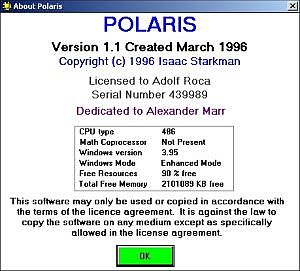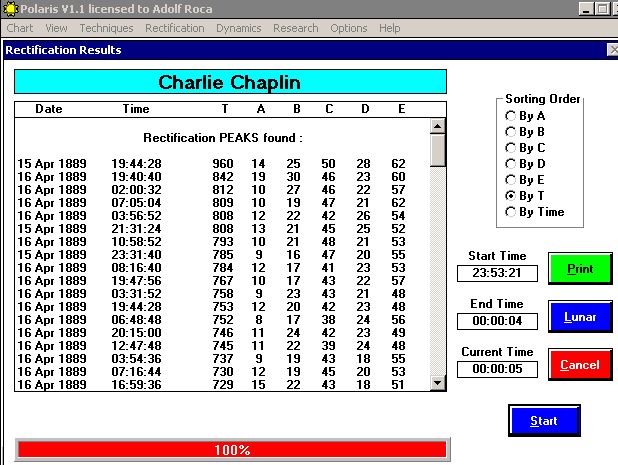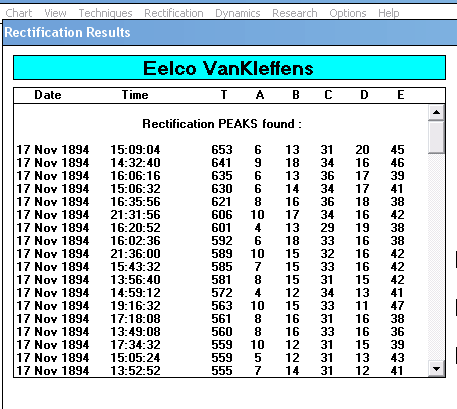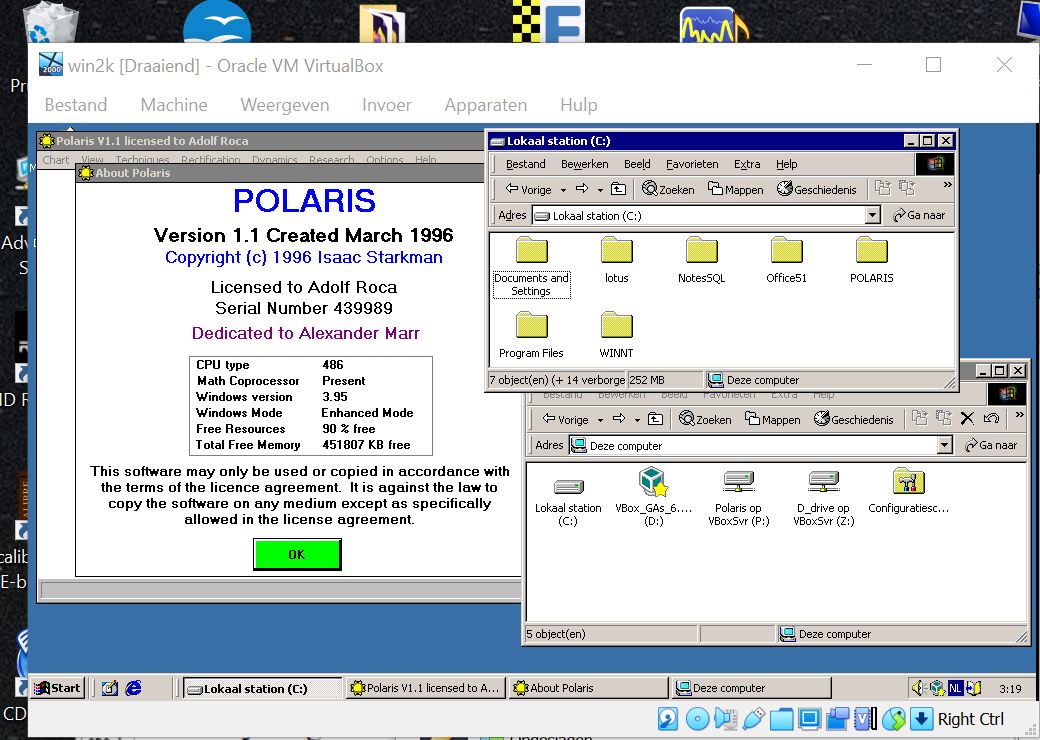![]()
Polaris is a 16 bits Windows program that was developed to run under 16 bits Windows for Workgroups (1993) and Windows 95 by the Israeli astrologer Isaac Starkman. Polaris is used to do automatic birth time rectification using several progressive techniques. The rectification method relies mainly on Alexander Marr's techniques with Primary Directions (PD) using the Topocentric system.
The program calculates for a range of birth times the transits of life events and gives scores to them. Alexander Marr's method of scoring is partly is described in the book Predictive astrology of Starkman's friend Juan Estadella. To do the mathematical calculations, the processors of nineties needed the help of a mathematical co-processor to get the job done in a reasonable amount of time, just like the processors of that time needed specialised video and sound charts to play video in real time. A math co-processor or Floating-point unit (FPU) speeds up floating point calculations a hundred times, so that the 5400 calculations done every 8 seconds during a 12 hours time span would take hours or days, but not weeks or months.
 The
Pentium Intel processors that followed up the 80486DX chip integrated
floating-point hardware on the main processor chip, but when Polaris
was written cheaper 486SX chips with a disabled FPU were still
prevalent. For this reason Polaris checks if a mathematical
co-processor is available. If the co-processor is recognised, fast
code for arithmetic calculations are sent to the floating point unit.
If the math co-processor is not recognised in a modern processor more
elaborate calculations must be done by the not in floating point
calculations specialised main processor, which slows down the
calculation process a hundred times.
The
Pentium Intel processors that followed up the 80486DX chip integrated
floating-point hardware on the main processor chip, but when Polaris
was written cheaper 486SX chips with a disabled FPU were still
prevalent. For this reason Polaris checks if a mathematical
co-processor is available. If the co-processor is recognised, fast
code for arithmetic calculations are sent to the floating point unit.
If the math co-processor is not recognised in a modern processor more
elaborate calculations must be done by the not in floating point
calculations specialised main processor, which slows down the
calculation process a hundred times.
Under Polaris / Help / About Polaris you can see if the FPU will be used by Polaris. In the case on the right Polaris sees a 486 Intel processor without a mathematical co-processor (not present). So, more elaborate routines will be used to do the needed floating point astrological calculations, that could do the not recognised integrated math processors of Pentium processors at Warp speed.
Polaris recognises a Windows version 3.95 with plenty of memory, while it actually was used in a Virtual Box PC emulator running Windows 4.0 (2000) with fixpack 4 under Windows 10 on an Asus Mini PC with an OctalCore AMD Ryzen 7 4800U processor with a maximal clock speed of 4300 MHz. It could run 4300/50 is 86 times faster than a 486DX at 50 Mhz with a mathematical co-processor. But because the available, but not by Polaris detected eight floating point units of the AMD processor were not used, the mathematical calculations done by Polaris took still many hours. But when Polaris sees the virtual environment it needs, its speeds up much faster. We can then do thousands of astrological calculations in several minutes instead of many hours.
But the good news is that even a 2 Gigabyte laptop processor runs at least 40 times faster than a 50 Mhz 486 processor. So, if Polaris does not recognise the in your modern processor built in math co-processor, you do not need to wait days or weeks for calculations done on modern hardware. And because the modern PC hardware and operating systems are much more stable than the operating systems and hardware of the nineties, running Polaris on modern hard- and emulation software is still the best way to check the claims of Starkman and Marr, that rectification using Primary Directions with the Topocentric system still works.
See: Chart Rectification - Astrodienst Astrowiki :
But if you can get support for the mathematical co-processor on a modern 4 MHZ PC, the calculations needed to check the rectification claims of Richard Starkman will be done in minutes instead of many hours, which makes both the rectification process and the needed fact checking much more easy.
But NOT that technically inclined people might still believe in the traditional ways of fact checking. As they may have read many astrology books and courses proclaiming the in their opinion right direction. And so the difficult question seems te be settled in their cognitive bubble. It is as it in our closed, but secure community of knowing-it-all.
On what date and at which time Charles Chaplin was born in London according to the Topocentric directions? And how does this fit with the by AstroDienst provided facts? Compare the picture below with the ADB.

In
the case presented 25*60*60/4 is 22.500 birth-times between April 15
19h00 and April 16 1889 20h00 were evaluated according to the
Topocentric House System in only 7 minutes. The calculation time
needed can be deducted from the difference between Start and End
Time. We see one peak for 15 April and many other peaks for 16 April
at GMT times when birth-times were recorded hourly.
How do we interpret those (maybe irrational, but evident) mathematically found facts? Was Charlie Chaplin most likely born at 8 PM in London at April 16, 1889 as most astrologers expected or circa 8 PM on the day before? Or is April 15, 1889 statically seen the best option? What are the known facts and flaws? And how should we know?
If Polaris “works”, Polaris should suggest the best fitting birth time by way of many calculated rectification peaks. But what does this mean? And which score or better combination of scores was most predictive? And with what probability?
One might assume that the correct time should be listed in the top eighteen results as shown above, but there are still 25*60*60/4 is 45.000 minus 18 other candidates in a 25 hours rectification contest. They were not listed. Could they be ignored? No, as many tiny effects still do matter. In a democratically chosen parliamentary system minority parties should still have a voice. Maybe they wil not have sufficient impact on the major economic questions, but they still should have a voice on questions that do matter for them. And statistically seen, one of not shown 45.000 minus 18 possible is thousand times more likely to provide the best candidate, unless the correlation between high scores and the correct birth time is super strong. If the top 18 performers in a contest score together 36 thousands points, they still score less than 45.000 losers having only one like. So getting the right result is always very unlikely with 45.000 minus G'ds One degree of freedom. Unlike you happen to be a special knight of G'd.
But let us not speculate on the symmetry of sacred numbers, but just do some blunt statistics. Suppose we had only four possible birth-times with a relative likelihood of respectively 1, 2, 3 and 4 more likely. Which time would you choose? Most people would bet on the best rated time with a 4/10 is 40 % chance of being correct, without realising that the risk on a wrong bet would be 60%. Should we trust a candidate that clearly won the election with only 10 % more votes? Most members of other parties would clearly state: No!
So guessing the right birth time after only displaying the Top(ocentric) top twenty winners in a gigantic contest with thousands of candidates seems statistically seen very unreasonable. But the found distribution of few rich men and many poor men is also unfair. Should we deny that unfair reality? No, as it is still the observed reality.
But the empirical problem is that there will always be some difference between what we (fore)see as right and what we in practice get. Scientists then speak of the usual bias and standard error. The big scientific question is how to deal with those potential sources of error. For that reason empiricists developed clever experiments and statistical methods to evaluate their experimental results.
Is there any empirical evidence that rectification works? I was not aware of it, so I started a rectifying a chart contest under ADB members on the ADB Forum.
In the ADB thread Rectifying a chart candidate Eelco Van Kleffens, Richard Starkman provided astrologically seen the most likely correct birth-time. It was four-and-a- half minutes away from the 17h00 local BC birth time. The chosen 16h35m56s GMT time ranked fifth in the Transit peaks list, but scored better in other points.

On 26.06.2016 at 01:18 [UT+1] former ADB user ganglion ended the contest that had started at 21.05.2016 at 19:16 [UT+1]
The idea behind rectification is that with knowledge of the exact birth-time major personal events could be astrologically predicted and explained using small orbs based on empirically found facts. Thus not with the habitual astrological I guess expectations, but with more or less certainty that empiricists using P-values are acquainted with. They know that the factor change does exists and that prejudices can trouble the mind. Chart rectifiers know that things are not always the way they apparently seem to be.
See also my NVWOA article Automatische rectificatie van de geboortehoroscoop (August 2024) about the rectification of the horoscope of Abraham Bueno de Mesquita. According to his BC he would have been born at 1h00 AM with Ascendant 0°33' gemini, but at 0h58 we see an Ascendant 29°50' taurus. Which mask fitted this well-known Dutch-Jewish public persona the best? He certainly did not behave like an down to earth taurean prophet, but more like a versatile populist and comedian like Donald Trump. Presenting a new sheriff in town.
I struggled with this riddle, like Jacob wrestled with the angel and asked the inspiring me astrologer Isaac Starkman about his opinion.
The best rectified birth-time is thus most likely the time in the expected range, say plus minus a hour around the found BC time, that seems to be best explaining the earlier found events. And that corrected time should also better predict future events, which is the major reason that in astrology believing people are interested in chart rectification. But if there is no reliable BC time available, rectification should use a large time span, risking the popping up of many false positive times. I guess the not by wings supported April 15 1889 peak at 19h44m28s of Charles Chaplin could be one of them.
 But
without exact AA birth times empirically inclined astrologers cannot
know anything for sure. They could only speculate enormously on
individual charts with the precision of say +/- 30 minutes. Unless
there is some higher divine instance, guarding us for the well known
human falllacies.
But
without exact AA birth times empirically inclined astrologers cannot
know anything for sure. They could only speculate enormously on
individual charts with the precision of say +/- 30 minutes. Unless
there is some higher divine instance, guarding us for the well known
human falllacies.
And that is what all humans actually do, when they encounter newly discovered facts. During the Covid pandemic, every internet troll or self-proclaimed virus expert could propose his or her unique view on the found facts. They applied their own or shared with others unique theory on it, without realising that their sophistically tricks has already been debunked for centuries ago. It was just the way you or your ancestors saw it. But your well educated view on the whole does not yet see the whole story.
It looks like the conditon humaine as the Belgian surrealist René Magritte referred to:
That is the eternal tunnelled vision trap people are stuck in. About this problem wrote famous rock stars like Peter Gabriel in his Genesis song the Carpet crawlers and Jimmy Page in his Stairway to Heaven. How to overcome the us eternal hidden in plain sight repeating patterns? Eternal time will tell us all, if your words were timely tuned eternal songs and intentions (eternal philosophy) or just lost and broken false words in time... But according to in rearcanation
But how can realise it? Just by studying your here and now? I am an
Realising this normal human ego trap is step one. Doing uncensored and spontaneous independent research on the found facts is step two. And that is what we all do. Publishing those independently found facts is the third step. But in many countries and groups the simple idea of telling the childish truth is still seen as an illegitimate act. As it disturbers the cosy views of better knowing others. As it questions their official view of law and order. For this blunt reason many Russians were criminalised. But their sentence helped them to see more clearly the corrupt Mafia state they were endorsed in.
Polaris was developed for Windows for Workgroups 3.11 (WfWG). It runs on any Operating System that supports 16 bits Windows applications. In theory the following operating systems could be used:
16 bits Windows 3.0 (1990), Windows 3.1 (1991) and WfWG 3.11 (1993) that added networking support.
Hybrid 16/32 bits versions Windows 95, 98, ME.
32 bits versions of Windows NT, Windows 2000, Windows XP and Windows 7.
OS/2 and OS/2 derivatives like eComstation.
Using a legacy NT Virtual DOS Machine (NTVDM) under 32 bits Windows 10 version (not yet tested).
Not (yet) working in my practice are Wine and Wabi for Linux.
Releases · otya128/winevdm · GitHub enabled me to install Polatis under Windows 11. But it was slow.
Most licensed users ran Polaris on an dedicated Windows 9x or XP PC with a mathematical coprocessor. With the exception of the OS/2 or Linux derivatives, the supported operating systems should not be used in a network environment, as the risk of a virus infection is very large. But long lasting calculations can easily be interrupted on fragile hardware and one day the outdated hardware will definitely fail. But replacing an old computer with a new and faster hardware can be a nightmare, as the old operating systems have no support for modern hardware. So now old and once cherished and fairly paid for software could be lost, when you update your old laptop or PC in nowhere land. Could you rescue your old software and data?
Yes, you can. As you can clone the essential software of an outdated Windows PC or laptop forever and restore it as a Windows Hyper-V mirror that is running in a window on a much faster modern PC.
The only rational way to go around with outdated software on a new PC is virtualization. As you cannot install an outdated operating system on a modern PC with a modern ACPI BIOS, but a virtual PC emulator mimicking old hardware can run outdated operating systems super fast. And though there will be some overhead because of the PC simulation, most programs that do not need a fast 3D video-card will run in practice almost as fast under a well tuned Virtual PC computer as they would under the original operating system and hardware.
I managed to run Polaris super fast under Windows 2000 in Oracle VM VirtualBox. Installing Polaris under win2k under version 6.1 of VirtualBox solved for me many problems.
In earlier versions of VirtualBox I could not enable the mathematical co-processor under the guest OS. I could benefit from a 4 GHz processor speed - a modern 4 GHz processor is at least 4000/25 is 160 times faster than a slow a 25 MHz 486 processor - but the built-in advanced mathematical co-processor was not recognised by Polaris. So Polaris used hundred time slower calculating routines. But now the fast mathematical co-processor routines can be used as you can see in the screen shot below. Rectification's can now be done at warp speed. It takes ten minutes instead of many hours or days on a modern PC.

The
so-called host PC is a 64 bits Windows 10 system. The 64 bits
VirtualBox computer emulator runs the 32 bits Windows 2000 guest that
runs 16 bits Polaris. Windows 2000 was the first stable (NT
technology) Windows version with full support of DOS, 16 and 32 bits
Windows applications. It is lean and mean compared to Windows XP and
does not need the dangerous (and now disabled) online activation to
keep running. You need a installation CD or iso file with a valid
serial number to install Windows 2000.
Networking was disabled in Virtual Box to prevent viral and worm infections of the outdated Windows version. But exchange of files without network card is still possible by using locally Shared folders on the host PC:
 The
Guest
Additions for Windows should be installed to enable excellent 2D
video support, clipboard, drag and drop and shared folders that
integrate the guest with the host PC without major security risks.
The
Guest
Additions for Windows should be installed to enable excellent 2D
video support, clipboard, drag and drop and shared folders that
integrate the guest with the host PC without major security risks.
Polaris was designed to print the output to a local printer. I thus installed a Xerox postscript printer under Windows 2000 that prints the output to a ps-file in a shared folder to view or print the results under a postscript viewer like GNU Ghostview. The by the virtual printer produced postcript files are found in the Polaris directory.
Users of Windows Professional 10 might be using the Hyper-V hypervisor provided by Microsoft. Recent versions of Virtual Box can run under the Hyper-V drivers, but at the cost of speed and features. See: Using Hyper-V with Oracle VM VirtualBox.
Microsoft's Hyper-V is of no use for our purpose. It disabled the by KVM recognised math co-processor under VirtualBox and it does not allow us to install 32 bits operating systems like Windows 2000 under VM Manager.
Nevertheless, it is possible to switch between the by Microsoft (Hyper-V) and by Oracle VM VirtualBox (KVM) preferred hypervisors, as both hypervisors allow us to freeze ongoing calculations in their guest operating systems in a hibernation state that can be reactivated at wish. Under VirtualBox it is called Save the machine state and under .
You can read in Run Hyper-V, VirtualBox and VMware on same Computer how to enable or disable Hyper-V after a Windows reboot.
Of course this method of retrieving alternative data from an outdated 16 bits computer program (March 1996) may be troublesome for modern computer users, but the by Alexander Marr provided and by Richard Starkman implemented rectification methods are the only proved to be effective rectification methods that I know.
See also the well known Butterfly effect:
But in science being able to repeat the original experiments is crucial. And to do this one needs to have access to the original documentation and methods used. And this is not the same as the hear say knowledge and usual interpretations afterwards of mainstream scholars.
For this simple reason getting Polaris to work (star) again under modern hardware was important to me. Can we reproduce Starkman's rectification findings? Would we draw the same conclusions from the same input?
Who knows how many times William Lilly's Christian Astrology was edited, before it became a best-seller like the Christian Bible? Which details were left out and which details were stressed to do some better story telling? Welcome in the New Age!
Download Polaris rectification software
How to Install Windows 2000 in VirtualBox - SYSNETTECH Solutions
 Conrad
mirrors Microsoft
Software Library Mirror - Conrad's Home with the self extracting
zipped Winfloat
package.
Conrad
mirrors Microsoft
Software Library Mirror - Conrad's Home with the self extracting
zipped Winfloat
package.
The DOS TSR HIDE87.com prevents the Windows GPF in WIN87EM.DLL under 16 and 32 bits Windows that crashed Polaris. But it also disables any opportunity to run Polaris at Warp speed.
Ghostscript, Ghostview and GSview can be used for printing to files on shared folders.
Evidence that chart rectification works - Page 6 - Skyscript Astrology Forum
Chart Rectification - Astrodienst Astrowiki :
Topocentric House System - Astrodienst Astrowiki:
Old 16-bit Application Causing GPF in WIN87EM.DLL, intermittently
<monitor_control.enable_rigorous_fpu_save_restore = “true”/>
Daily Horoscope: Polaris Software- A Critical Analysis:
My relationship with Isaac Starkman started at the now closed ADB Forum thread Rectifying a chart - a challenge:
I would like to end with Psalm 82:6 referring to the sixth day on which mankind was created:
But do not forget to understand the foregoing disclaimers:
Shalom! Be welcome on sometimes seemingly weird days of creation. Be welcome on this meeting again and again! This is our bloody world! And it is not the same as the by the Kremlin censured version of it. See: apologetics - How do proponents of the Fine Tuning argument for God, refute the puddle comparison? - Christianity Stack Exchange
Anthropic principle - Simple English Wikipedia, the free encyclopedia:
Amen